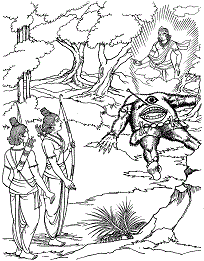Slaying of the rākṣasa Kabandha is one of the fascinating episodes in Ādikavi Vālmīki's Rāmāyaṇam. This oft-quoted episode appears at the end of the Araṇya-kāṇḍa (cantos 69-73). After Rāvaṇa abducts Sītā, Rāma and Lakṣmaṇa move southward in search of her. During their journey, they come across the impassable Krauñca forest, where Kabandha seizes them. Gigantic and grotesque, the rākṣasa had no head, neck, and legs. It was just ruṇḍa without muṇḍa[1]. Two deadly arms extended to the stretch of a yojana on either side; using them, the rākṣasa crushed the life out of animals and stuffed them into its mouth—an appalling organ bang in the center of its belly, which housed its eyes, nose, and ears.
No sooner had Rāma and Lakṣmaṇa looked at the rākṣasa than it firmly seized them. Although valiant, the brothers couldn’t retrieve themselves from this stranglehold at first. As they struggled to break free, Rāma grew increasingly anguished. Somehow, Lakṣmaṇa regained self-control. He infused confidence in his brother, helping him regain his original might. Together, wielding their swords, the brothers then chopped off Kabandha’s arms.
Kabandha, who had been cursed, was freed from it upon Rāma’s contact. Assuming his divine form, Kabandha directed the brothers to Śabari’s hermitage. He also advised them on how to win back Sītā.
This is the main storyline of the Kabandha episode.
Whenever I think of this story in the backdrop of Rāmāyaṇam, I am amazed by Vālmīki’s supreme imagination, his insight into human nature, and unparalleled poetic skill. To me, this episode is replete with psychological undertones. I see it as a ‘Depression Analysis’ carried out by Vālmīki[2].
I have nothing against Rāma’s divine dimension, but I am more drawn to his human nature. Those instances where the truthful and magnanimous Rāma acted according to his own words—“ātmānaṃ mānuṣam manye,” “I see myself as a human being”—appeal to me. His jīva-dharma means a lot more than deva-dharma, for unlike the latter, we can try to emulate it. If we consider Rāma solely as a deity, ancient words warn us against following him—“na devacaritaṃ caret.” Often this is reason enough for most people not to even try following Rāma’s ideals. All activity will stop at bowing down before him. Instead, if we look at him as a human, we have a lot to gain in terms of values. I sincerely feel that Rāma’s legacy can serve as a motivation to persevere for constructive values even in modern times.
Seen in this background, it is not inappropriate to understand the Kabandha episode as depicting Rāma’s depressed state of mind. Having lost his beloved, Rāma’s self-confidence was at an all-time low. Naturally, he was depressed. It is this state of depression that the rākṣasa Kabandha symbolizes.
Depression is one of the foremost mood disorders that is troubling our society. This, in the form of the rākṣasa Kabandha, possesses arms of the length of a yojana but has no head, neck, and legs. Downright disturbing. But what does this signify? As all of us know, no wisdom prevails in the state of depression. Logic conspicuously loses its meaning. This is why Kabandha has no head. Another result of depression is lack of dynamism; it makes a person unenergetic and stagnant. Therefore, Kabandha has no legs. Finally, depression is left with a single attribute—all-consuming attention, hunger that can dissolve within no time the confidence and vivacity of a person. We now get a clear picture of the rākṣasa with an outrageous paunch!
In this way, Vālmīki has impressively portrayed Rāma’s dejection by employing a symbol of depression. What is more impressive is that Rāma overcame this depression with the help of his brother. Awe-inspiring indeed.
It is this very depression that consumed Arjuna in the time of the Kurukṣetra war. This is also the signal feature of Hamlet, the prince of Denmark. While Arjuna could overcome depression with the help of the sound counsel offered by his friend Krishna, Hamlet could not. Neither his own intellect nor his friend Horatio could help Hamlet in casting it off. While Vālmīki and Vyāsa have analyzed depression in a positive manner, Shakespeare has done the same in a negative way. Doubtless, both these forms of poetic creation are suggestive of excellent, life-enriching values.
Let us return to our main topic of discussion. It is the general public feeling that depression is inflicting a lot of trouble in our times than it had ever done in the past. What might be its cause? With widespread urbanization and exponential increase in comfort levels, the ability of humans to withstand difficulties is on the decline. Also going downhill is mental stability and fortitude. It might perhaps be argued that there should be no great room for depression in a setting where there is ample opportunity to live—at a single time and place—amidst people of varied age-groups and temperaments. However, it is clear that with the growing attitude of exclusivism and the sharp need for privacy that follows, even small pains turn potent enough to cause depression.
So far we have looked at depression that is limited to worldly affairs. There is, however, another kind of depression encountered in the world of art. This might seem unintuitive, for in art, a medium meant to secure enjoyment, what could possibly cause depression? This seeming anomaly holds the key to understand rasa.
In the fifth act of Kālidāsa's Abhijñānaśākuntalam, the protagonist Duṣyanta—who had, by then, lost all memory of Śakuntalā because of the curse of sage Durvāsa—hears a tune sung by his queen Haṃsapadikā and makes a fascinating observation:
रम्याणि वीक्ष्य मधुरांश्च निशम्य शब्दान्
पर्युत्सुकीभवति यत्सुखितोऽपि जन्तुः।
तच्चेतसा स्मरति नूनमबोधपूर्वं
भावस्थिराणि जननान्तरसौहृदानि॥ (5.2)
Upon seeing charming sights and hearing euphonious melodies,
although one becomes happy, a strange wistfulness takes over.
His mind unconsciously recalls
affections from the past that live on in the heart.
It is intriguing that a person should feel a sense of longing, a peculiar wistfulness, after seeing wonderful sights and hearing tender sounds. It is profound pensiveness. In the process of art appreciation, we do not experience joy as we normally do when our sense organs are gratified. Instead, we feel a different sort of aesthetic delight, which is at once elevating and remindful of some strange incompleteness. We shed tears. Here lies the secret of rasa. In the words of the famous English poet Keats, it is ‘melancholy.’ John Milton explains it as ‘Il Penseroso.’ The Italian word ‘pensieroso’ means a kind of contemplative dejection. It closely resembles the Greek word ‘µέλαινα χολή—melancholia.’ In his poem The Buried Life, Matthew Arnold speaks of this concept:
“Yet still, from time to time, vague and forlorn,
From the soul's subterranean depth upborne
As from an infinitely distant land,
Come airs, and floating echoes, and convey
A melancholy into all our day.”
Charles Dickens remarks in his celebrated novel Oliver Twist:
“A strain of gentle music, or the rippling of water in a silent place, or the odour of a flower, or the mention of a familiar word, will sometimes call up sudden dim remembrances of scenes that never were, in this life; which vanish like a breath; which some brief memory of a happier existence, long gone by, would seem to have awakened; which no voluntary exertion of the mind can ever recall.”
This is a direct explanation of Kālidāsa's verse[3].
We can have a look at yet another example that is in tune with Kālidāsa's observation: In the fifth act of Shakespeare’s Merchant of Venice, when Lorenzo lapses into an appreciation about music, Jessica says, “I am never merry when I hear sweet music.”
It is clear that while the depression caused by indulging in worldly affairs pains a person, the melancholy caused by involving in art does not bring about any pain. On the contrary, it creates a feeling of contentment; a state, albeit temporary, of being free from desires— tṛṣṇākṣaya-sukha. Is this not fascinating?
This is perhaps why Abhinavagupta, while explaining the seminal rasa-sūtra in Bharata's Nāṭyaśāstra, cites the aforementioned verse and makes it a point to clarify the meaning of the word ‘smarati’ used in it. According to him, its meaning should not be restricted to ‘memory’ as the tārkikas explain. Because, he says, it actually means a revelation—rasa itself revealed through a flash, pratibhāna, at a moment of incisive insight. During this process, therefore, likes and dislikes dissolve and pure, non-qualified enjoyment remains as experience. This experience is neither worldly (laukika) nor delusional (mithyā). To put it in a nutshell, worldly depression is invariably associated with self-interest; it therefore causes anguish. Melancholy associated with art, on the other hand, is meta-worldly, alaukika. Since self-interest has no bearing at this level, it does not cause pain, but instead brings about serenity of the mind, citta-viśrānti.
Footnotes
[1] In Sanskrit, muṇḍa means head and ruṇḍa refers to the body minus the head. Of late, it has become quite common in Kannada to use these two words in wrong contexts, one in place of the other. Hence this clarification.
[2] Kuvempu uses this aspect beautifully in his epic-poem Śrirāmāyaṇadarśanam.
[3] There is ample evidence to the support of the fact that Kālidāsa's works were popular in England even during Charles Dickens’ time.


















































Comments